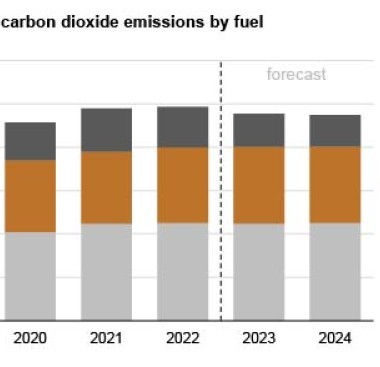Energy
Energy industry news - solar, wind, hydroelectric, natural gas, petroleum.

Average US gasoline prices are higher this Thanksgiving than any since 2012
| November 24, 2021 | Energy
The average price that consumers paid at the pump for U.S. regular gasoline on the Monday before Thanksgiving this year was $3.40 per gallon (gal). This price is $1.29/gal (62%) higher than last year and is the highest pre-Thanksgiving price since 2012 (in nominal terms), according to our latest Gasoline and Diesel Fuel Update. U.S. gasoline prices are 82 cents/gal (32%) higher than at the same time in 2019, before the COVID-19 pandemic. October 2021 had the largest recorded year-over-year increase in gasoline prices, at $1.13/gal, since we began collecting gasoline prices in 1990.
U.K. promises $27 million for turbines that harness tidal power
| November 24, 2021 | Energy | Alternative
Warren questions US gas producers on exports ahead of winter
| November 24, 2021 | Energy
Lawmaker says White House is mulling ban on crude oil exports
| November 23, 2021 | Energy

Major U.S. utilities spending more on electricity delivery, less on power production
| November 23, 2021 | Energy
Over the past decade, major utilities in the United States have been spending more on delivering electricity to customers and less on producing that electricity.

US gasoline barges head to Western Canada after flood damage
| November 23, 2021 | Energy | Maritime | Bulk | Ports & Terminals
U.S. barges carrying gasoline are headed to Canada’s west coast to deliver much-needed fuel to a region cut off from the rest of the country after last week’s rainstorms brought flooding and landslides that damaged transportation links.
US sanctions ship involved in finishing Nord Stream 2 pipeline
| November 23, 2021 | Energy
U.K. energy bills to balloon as consumers pay for Bulb collapse
| November 23, 2021 | Energy
Keystone pipeline developers seek $15 billion from US for cancellation
| November 23, 2021 | Energy
Wind giant Vestas drops as cyber attack risks output delays
| November 22, 2021 | Energy | Alternative | Project / Heavy Lift | Maritime Project

Ørsted acquires Lincoln Land Wind in Illinois in continued expansion of its operational footprint in the US
| November 22, 2021 | Energy | Alternative
With the acquisition of the 302 MW operational wind farm, Ørsted enters the U.S. MISO market, which covers 15 states in the Midwest and the South. Lincoln Land Wind is fully contracted via power purchase agreements (PPAs) with Meta, formerly the Facebook company, and McDonald’s Corporation (‘McDonald’s’). Lincoln Land Wind reached commercial operation on November 17.

Searoutes raises €2.4 million to reduce shippers’ GHG emissions
| November 22, 2021 | Energy | Alternative | Maritime | Technology
Searoutes, the Marseilles-based start-up that helps shippers reduce the carbon footprint of their transport, has announced a €1.3 million financing round led by WSB Beteiligungs, the venture capital firm founded by Wolf Scheder.

Most planned US natural gas-fired plants are near Appalachia and in Florida and Texas
| November 22, 2021 | Energy
Between 2022 and 2025, 27.3 gigawatts (GW) of new natural gas-fired capacity is scheduled to come online in the United States, according to our latest Monthly Electric Generator Inventory. This added capacity would increase current capacity (489.1 GW as of August 2021) by 6%. Many of the planned natural gas-fired capacity additions are located close to major shale plays in the Appalachia region and Texas and in Florida.

Shale getting stingy? Reinvestment rates in the US hit historic lows in Q3 shaping record free cash flow
| November 22, 2021 | Energy
Reinvestment rates among US shale oil producers hit an all-time low in the third quarter of 2021, resulting in a record free cash flow for the quarter, and are projected to fall even lower by year-end according to a Rystad Energy analysis.
_-_28de80_-_9ba750cb29b479a114d8c31469aeac5ccd1ff647_lqip.jpg)
World’s first inline active heave compensator successfully tested by Seaqualize, together with Van Oord
| November 22, 2021 | Energy | Alternative | Project / Heavy Lift | Maritime Project
In no less than 62 hours of rigorous offshore testing, tech scale-up Seaqualize successfully completed offshore trials for its inline Active Heave Compensator (iAHC), the ‘Delta600’. Together with testing partners Van Oord and nautical research institute MARIN, the offshore lifting tool was tested for fixed-to-floating, floating-to-fixed and floating-to-floating transfers of 300mT loads. The Delta600 is DNV certified and ready for work.
Shell to acquire energy retailer, Powershop Australia
| November 22, 2021 | Energy
Several Rotterdam terminals to be ready for hydrogen imports by 2025
| November 22, 2021 | Energy | Alternative | Ports & Terminals

Crowley advances major fuel services project in Australia with Saunders International
| November 22, 2021 | Energy
Crowley has reached agreement with Saunders International Ltd. to provide engineering, procurement, construction and management (EPCM) services, as well as construction of multiple bulk fuel storage tanks. The agreement is a vital component to enable Crowley’s fuel management and storage services in Darwin, Australia, serving U.S. military operations in the Pacific.

Fuel switch cuts greenhouse gases at Port of Long Beach
| November 19, 2021 | Energy | Alternative | Ports & Terminals
SSA moves to renewable diesel for cargo-handling equipment

EIA expands data coverage of biofuels in its Monthly Energy Review
| November 19, 2021 | Energy
In October 2021, we began publishing expanded data on biofuels other than ethanol in our Monthly Energy Review (MER), including production, imports, feedstocks, and consumption. The expanded biofuels data provide a more detailed look at fuels previously grouped under renewable fuels except ethanol, which is now split into biodiesel, renewable diesel, and other biofuels.
© Copyright 1999–2024 American Journal of Transportation. All Rights Reserved





